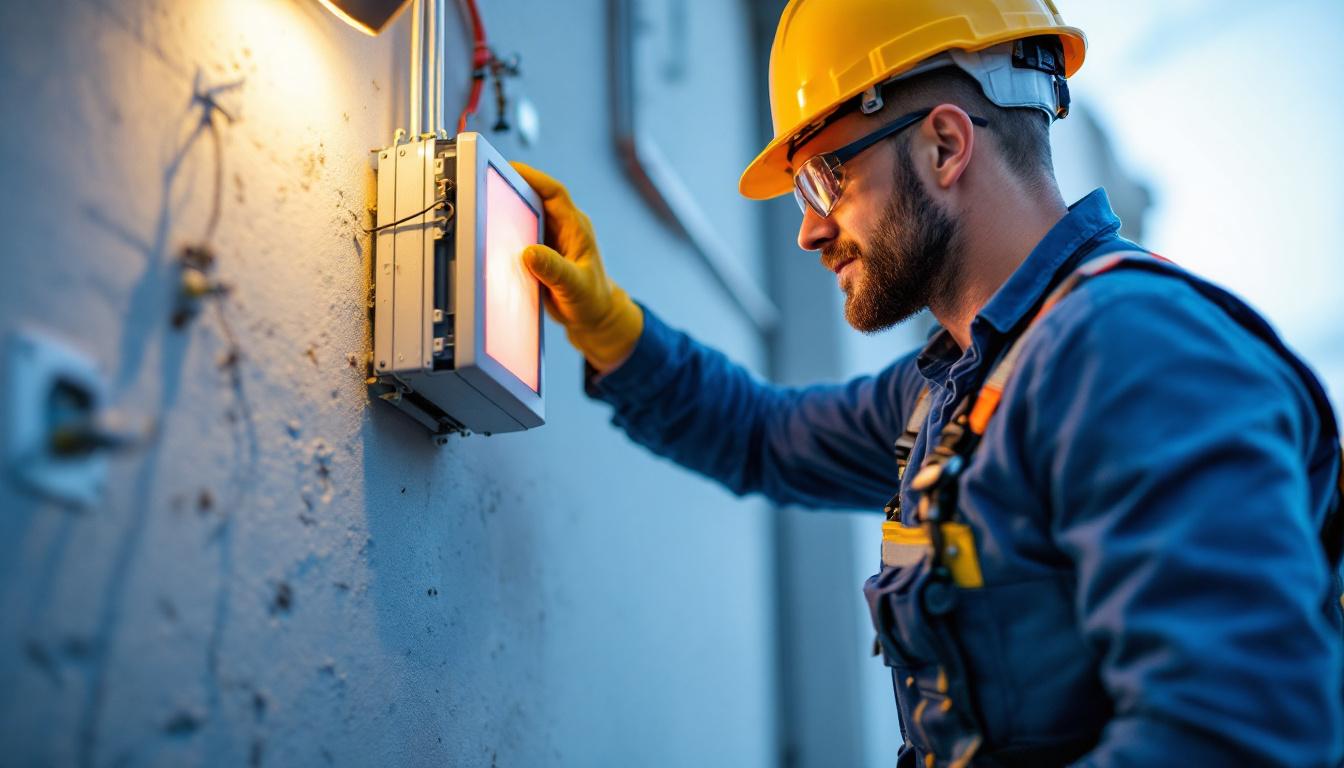
Emergency wall packs with battery backup have become a critical component in commercial and industrial lighting systems. These fixtures provide reliable illumination during power outages, ensuring safety and code compliance. Unlike standard wall packs, the inclusion of a battery backup allows the light to operate independently of the main power source for a specified duration, typically 90 minutes or more. This feature is especially vital in environments where safety is paramount, such as hospitals, schools, and warehouses, where a sudden loss of lighting can lead to hazardous situations.
For lighting contractors, installing and maintaining these units involves more than just swapping out a fixture. The complexity of integrating battery technology with lighting controls, ensuring code compliance, and addressing site-specific challenges makes this a specialized task. Additionally, contractors must consider the varying requirements of different facilities, which can include factors like the layout of the building, the type of activities conducted within, and the specific local codes that govern emergency lighting. This necessitates a thorough understanding of both the technical specifications of the wall packs and the regulatory landscape.
Furthermore, the technology behind these emergency wall packs has evolved significantly, with many units now featuring LED bulbs that offer enhanced energy efficiency and longer lifespans compared to traditional lighting options. This shift not only reduces operational costs but also minimizes the environmental impact, aligning with the growing emphasis on sustainability in building practices. Moreover, modern emergency wall packs often come equipped with smart technology that allows for remote monitoring and diagnostics, providing facility managers with real-time data on battery health and operational status. This capability ensures that any potential issues can be addressed proactively, further enhancing safety and reliability.
In addition to their practical applications, emergency wall packs also play a crucial role in emergency preparedness and response plans. By providing clear and consistent lighting in critical areas such as exits, stairwells, and assembly points, these fixtures help guide occupants to safety during an emergency. The strategic placement of these lights can significantly impact evacuation efficiency, making it essential for facility managers to conduct regular assessments and drills to ensure that all emergency lighting systems are functioning optimally. As the importance of safety in the workplace continues to rise, the role of emergency wall packs with battery backup will undoubtedly remain a focal point in the conversation surrounding effective emergency preparedness strategies.
Emergency lighting is governed by a variety of codes and standards, including the National Electrical Code (NEC), the International Building Code (IBC), and guidelines from the National Fire Protection Association (NFPA). These regulations specify where emergency lighting is required, how long it must operate, and the minimum illumination levels. Compliance with these codes is not just a matter of legal obligation; it is crucial for the safety of building occupants during emergencies. For instance, in the event of a power outage or fire, properly installed emergency lighting can guide individuals to safety, significantly reducing panic and the risk of injury.
For contractors, the challenge lies in interpreting these codes correctly and applying them to each unique project. For example, emergency wall packs must often provide illumination along egress paths, entrances, and exterior walkways. Failure to meet these requirements can result in costly rework or failed inspections. Additionally, contractors must consider the specific needs of each building type, as different facilities—such as hospitals, schools, and commercial spaces—may have varying requirements based on their occupancy and usage patterns. This complexity necessitates a thorough understanding of both the codes and the unique characteristics of each environment.
Codes evolve frequently. A lighting contractor must stay current with changes to ensure installations remain compliant. This requires ongoing education and sometimes re-evaluation of existing installations. Given the safety implications, there is little room for error. Furthermore, as technology advances, new lighting solutions and energy-efficient options emerge, which may also influence code requirements. Contractors must not only familiarize themselves with the latest regulations but also with innovative products that could enhance safety and efficiency in their projects.
Moreover, the process of keeping up with code updates can be time-consuming and often requires attending workshops, seminars, or online courses. Networking with industry professionals and participating in relevant associations can also provide valuable insights into upcoming changes and best practices. Staying informed is essential, as non-compliance can lead to severe penalties, including fines or even legal action in the event of an incident. Therefore, a proactive approach to education and adaptation is vital for contractors who wish to maintain their reputation and ensure the safety of the spaces they illuminate.
Choosing the appropriate emergency wall pack involves balancing lumen output, battery capacity, fixture durability, and environmental suitability. Contractors must assess the site’s lighting requirements, including the size of the area, ambient light conditions, and mounting height.
For example, a wall pack installed in a high-traffic commercial area may require a higher lumen output and a robust housing rated for wet locations. Conversely, a fixture for a covered loading dock might prioritize different features. Additionally, factors such as the color temperature of the light can impact visibility and safety. A cooler color temperature, typically around 5000K, can enhance clarity and alertness, making it an excellent choice for areas where quick decision-making is critical, such as emergency exits or pathways.
Moreover, it is essential to consider the aesthetic aspects of the wall pack. In settings where design plays a significant role, such as retail environments or upscale office buildings, selecting fixtures that blend seamlessly with the architecture while still providing adequate emergency lighting is crucial. This balance of form and function can significantly influence the overall perception of safety and professionalism in a space.
The battery is the heart of the emergency function. Contractors must select batteries with proven reliability and appropriate capacity. Lithium-ion batteries are becoming more common due to their longer life and lighter weight, but they come at a higher cost compared to traditional sealed lead-acid batteries.
Understanding the trade-offs between battery types, including maintenance requirements and replacement cycles, is essential for making informed recommendations to clients. For instance, while lithium-ion batteries may offer a longer lifespan and reduced maintenance, they also require specialized charging systems and can be sensitive to extreme temperatures. On the other hand, sealed lead-acid batteries, while heavier and bulkier, are often more forgiving in terms of environmental conditions and can be a more budget-friendly option for many projects.
Additionally, the installation of battery backup systems should consider the potential for future upgrades or changes in building use. As energy efficiency standards evolve and technology improves, having a flexible battery system can save time and resources in the long run. Contractors should also be aware of local codes and regulations regarding emergency lighting systems, as these can dictate specific requirements for battery performance and testing protocols, ensuring that the selected wall pack meets all necessary safety standards.
Installing an emergency wall pack with battery backup requires careful electrical integration. The fixture must connect to the building’s power supply while allowing the battery to operate independently during outages. This often involves additional wiring and coordination with the building’s electrical system.
Contractors must ensure proper isolation of the emergency circuit to prevent unintended battery discharge and verify that charging circuits function correctly. Mistakes in wiring can lead to fixture failure or reduced emergency runtime.
Many emergency wall packs are mounted on exterior walls, which can present physical challenges such as uneven surfaces, limited mounting space, or difficult access points. Weather conditions and site security can also impact installation timelines and methods.
Contractors often need to adapt mounting techniques or use specialized hardware to ensure secure and code-compliant installations.
Once installed, emergency wall packs require regular testing to confirm that the battery backup operates as intended. This includes simulated power outages to verify illumination duration and battery health.
Contractors may face challenges coordinating testing schedules with building management, especially in occupied or sensitive environments. Additionally, some fixtures include self-testing features that can simplify this process but require familiarity with the technology.
Batteries degrade over time and need replacement to maintain emergency readiness. Tracking battery life cycles and scheduling timely replacements is critical. Contractors must educate clients on maintenance requirements and provide service options.
Failure to maintain the battery system can result in non-compliance and increased liability risks.
Issues such as flickering lights, failure to switch to emergency mode, or reduced runtime can stem from wiring errors, battery problems, or fixture malfunctions. Diagnosing these problems requires technical expertise and sometimes specialized diagnostic tools.
Emergency wall packs with battery backup represent a higher upfront investment compared to standard fixtures. Contractors must balance the need for quality components with client budget constraints. Offering options at different price points while explaining the long-term benefits of reliable emergency lighting helps manage expectations.
Clients may not fully understand the importance of emergency lighting or the complexities involved. Contractors play a key role in educating them about code requirements, safety implications, and the potential costs of non-compliance.
Clear communication about warranty terms, maintenance responsibilities, and lifecycle costs builds trust and supports smoother project delivery.
Modern emergency wall packs increasingly feature smart capabilities, such as remote monitoring, automated testing reports, and integration with building management systems. While these features enhance functionality, they also add complexity to installation and maintenance.
Contractors must develop skills in configuring and troubleshooting these systems, often requiring collaboration with IT and facilities teams.
Choosing fixtures that allow for easy upgrades or integration with emerging technologies can save clients money and effort down the line. Contractors who stay informed about trends in LED technology, battery chemistry, and wireless controls position themselves as valuable partners.
Emergency wall packs with battery backup are essential for safety and compliance, but their installation and maintenance present a unique set of challenges for lighting contractors. From decoding complex regulations to managing technical installation details and client expectations, success requires a blend of technical expertise, communication skills, and ongoing education.
Contractors who invest in understanding these challenges and developing tailored solutions will not only ensure code-compliant, reliable installations but also build lasting client relationships based on trust and professionalism.
Ready to tackle the challenges of installing emergency wall packs with battery backup? LumenWholesale is here to support you every step of the way. We provide contractors with spec-grade lighting products that meet the highest industry standards, ensuring your projects are equipped with reliable and high-performance lighting solutions. Take advantage of our unbeatable wholesale prices and free shipping on bulk orders to get the best value for your lighting needs. Don’t let hidden fees or inflated markups compromise your work. Choose LumenWholesale for quality, affordability, and convenience. Wholesale Lighting at the Best Value is just a click away.

Discover the insider tips and expert advice from lighting contractors on selecting and installing the perfect porch ceiling light.

Discover the transformative power of ceiling light fixtures in achieving energy-efficient lighting.

Discover the essential insights lighting contractors need when considering grow lights for sale.

Explore the advantages and drawbacks of using LED light panels in the lighting industry.